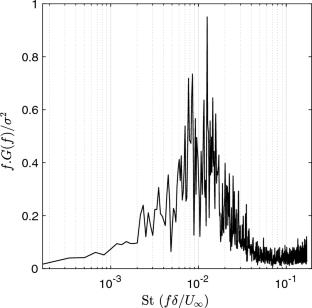Study of unsteadiness due to 3-D shock–boundary layer interaction in flow over a square-faced protuberance
Abstract
The dynamics of shock-induced unsteady separated flow past a three-dimensional square-faced protuberance are investigated through wind tunnel experiments. Time-resolved schlieren imaging and unsteady surface pressure measurements are the diagnostics employed. Dynamic mode decomposition (DMD) of schlieren snapshots and analysis of spectrum and correlations in pressure data are used to characterize and resolve the flow physics. The mean shock foot in the centreline is found to exhibit a Strouhal number of around 0.01, which is also the order of magnitude of the Strouhal numbers reported in the literature for two-dimensional shock–boundary layer interactions. The wall pressure spectra, in general, shift towards lower frequencies as one moves away (spanwise) from the centreline with some variation in the nature of peaks. The cross-correlation analysis depicts the strong dependence of the mean shock oscillations and the plateau pressure region, and disturbances are found to travel upstream from inside the separation bubble. Good coherence is observed between the spanwise mean shock foot locations till a Strouhal number of about 0.015 indicating that the three-dimensional shock foot largely moves to-and-fro in a coherent fashion.


 求助内容:
求助内容: 应助结果提醒方式:
应助结果提醒方式:


